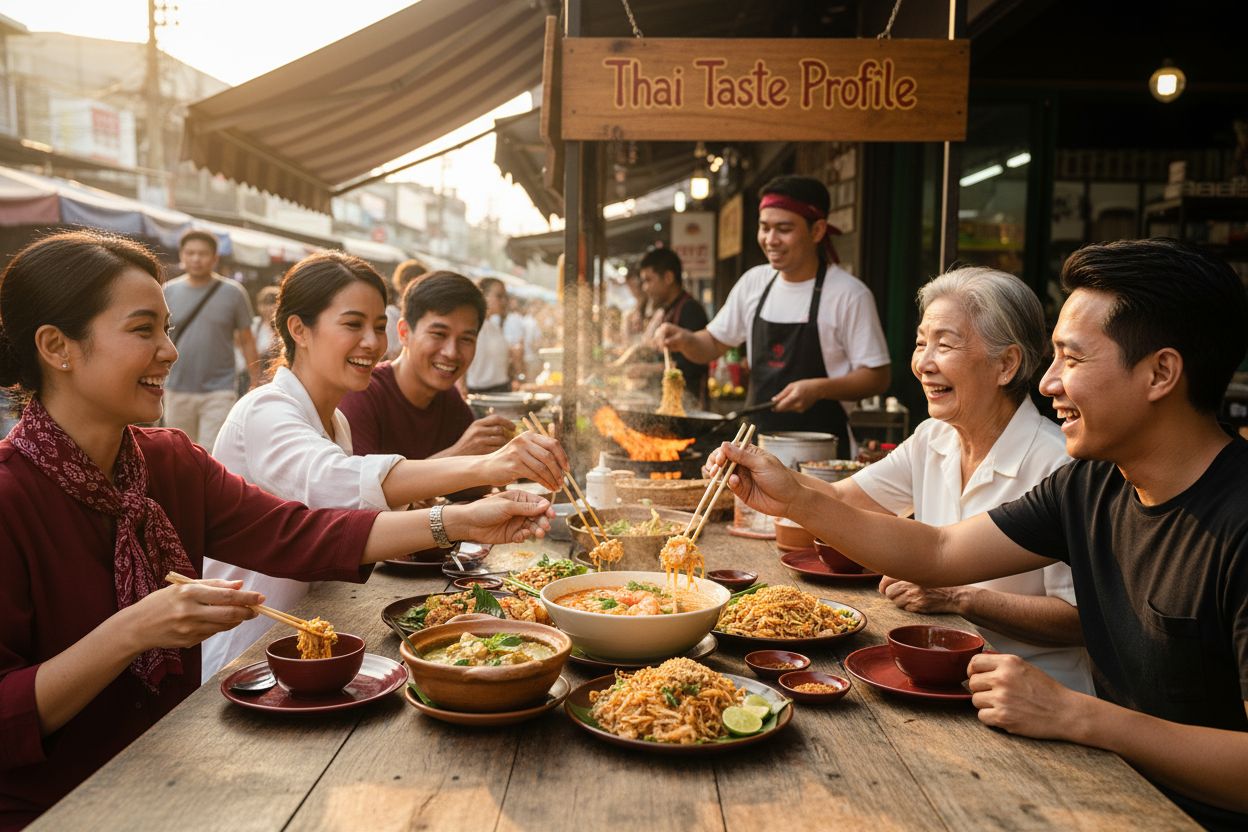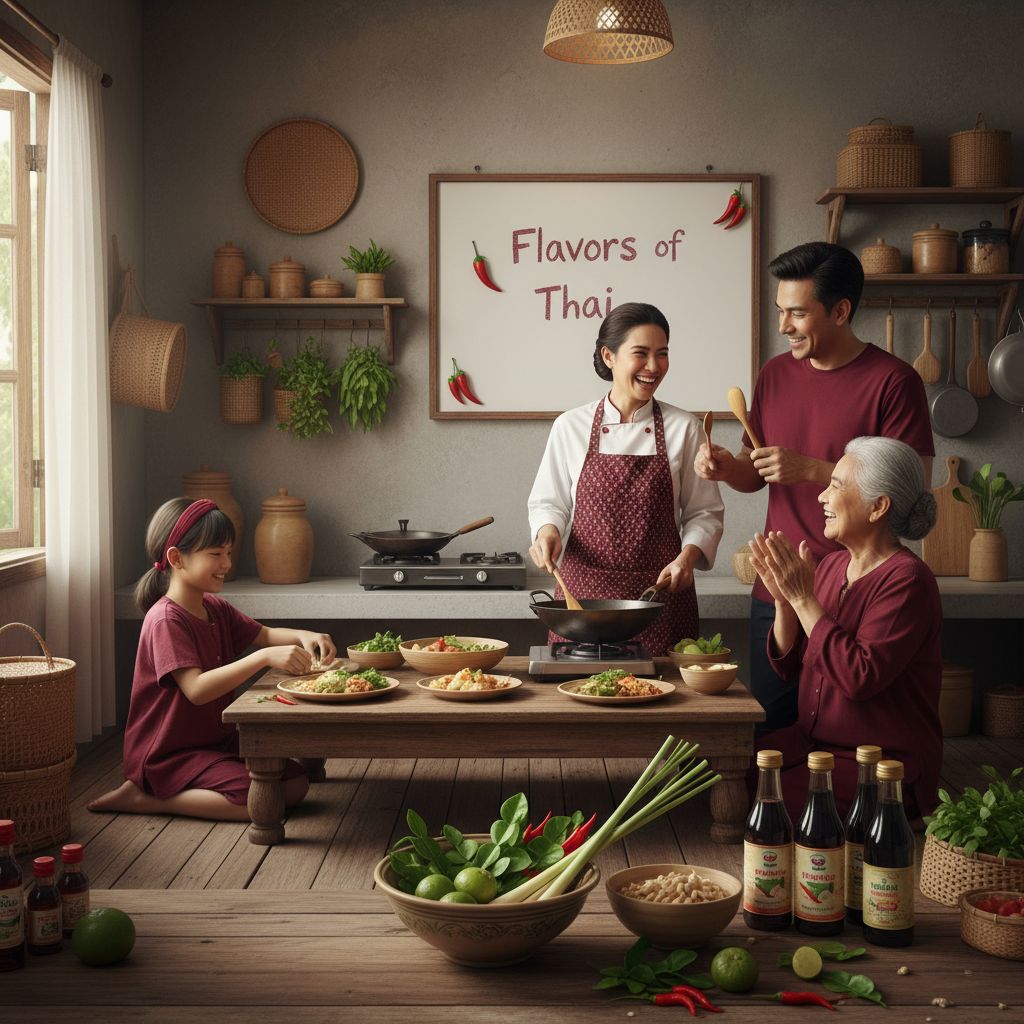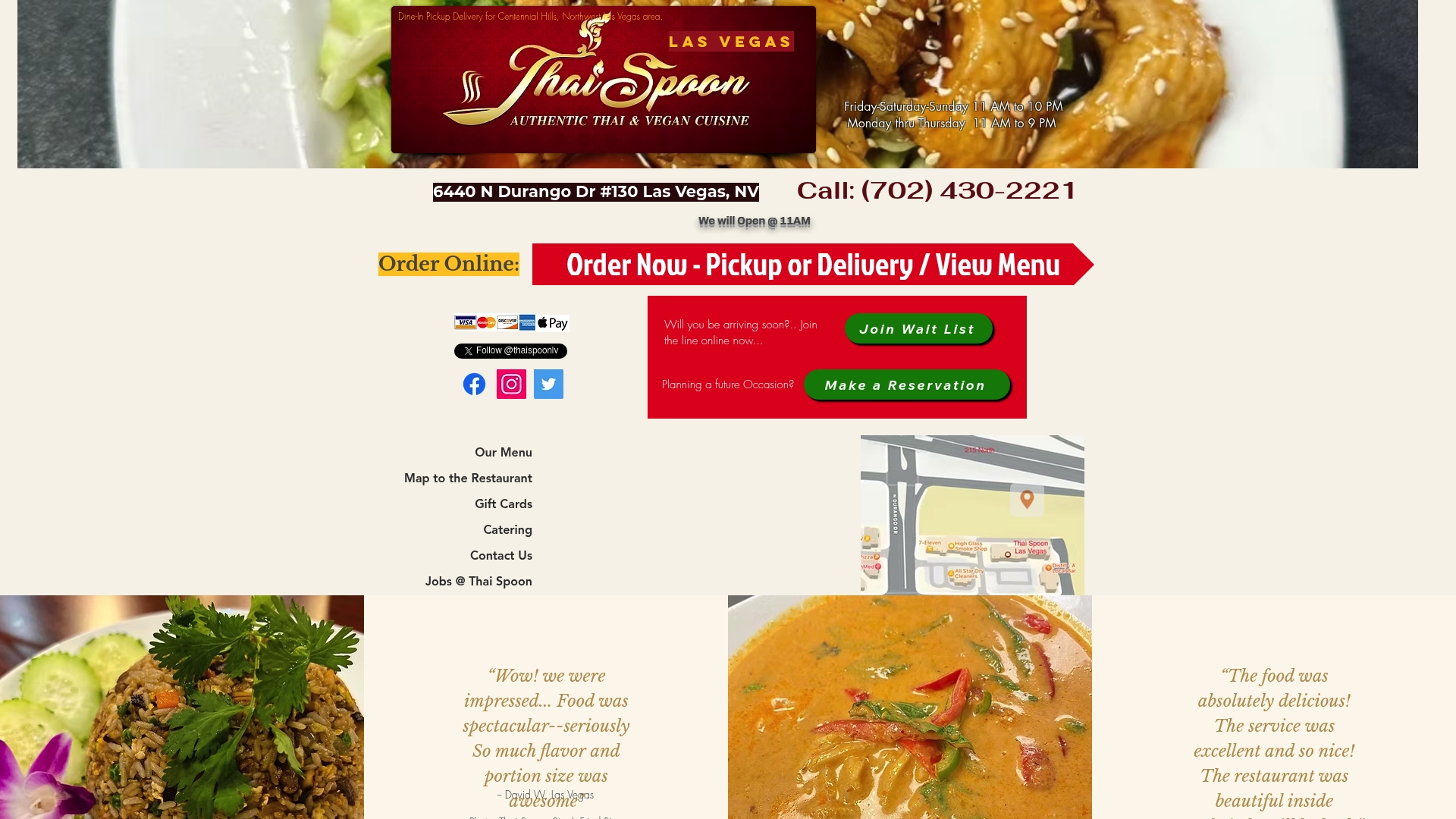What is a Thai Taste Profile? Understanding Its Flavorful Depth
- mail469793
- Oct 7
- 9 min read

Thai cuisine is famous for its vibrant flavors that hit every corner of your palate all at once. Most people expect the heat to steal the show, but Thai food actually balances four main elements—sweet, sour, salty, and spicy—in a way you rarely see elsewhere. What surprises most is that the magic comes from making sure no single taste ever takes over, and instead every dish gives you a perfectly tuned symphony of flavors in each bite.
Table of Contents
Quick Summary
Takeaway | Explanation |
Balance is vital in Thai cuisine. | Each dish achieves harmony through sweet, sour, salty, and spicy elements, enhancing the overall dining experience. |
Aromatics elevate flavor complexity. | Ingredients like lemongrass and kaffir lime leaves add depth and uniqueness, making dishes more than just tasty. |
Regional variations shape taste profiles. | Each Thai region contributes unique ingredients and flavors, creating a diverse culinary landscape worth exploring. |
Communal dining enriches flavor interaction. | Sharing multiple dishes allows for complex flavor combinations and enhances the overall enjoyment of the meal. |
Culinary balance reflects cultural philosophies. | The balance in cooking symbolizes unity and interconnectedness, offering a deeper understanding of Thai culture. |
Understanding the Key Flavors of Thai Cuisine
Thai cuisine represents a complex and vibrant culinary landscape characterized by an extraordinary balance of flavors that dance across the palate. Unlike many other culinary traditions, what is a Thai taste profile is fundamentally about creating harmony among seemingly contrasting taste sensations. Our guide on Thai cuisine culture explores this intricate flavor philosophy in greater depth.
The Four Fundamental Flavor Elements
At the heart of Thai taste profiles are four primary flavor components that work in remarkable synchronization:
Sweet: Often introduced through palm sugar or fruits
Sour: Typically achieved using lime juice or tamarind
Salty: Delivered through fish sauce or sea salt
Spicy: Generated by various chili peppers and heat-inducing ingredients
These elements are not just randomly combined but meticulously balanced to create a symphonic taste experience.
To clarify the foundational structure of Thai cuisine, the following table organizes the four main taste elements, their main sources, and their roles in overall flavor balance.
Flavor Element | Typical Ingredients | Role in Thai Cuisine |
Sweet | Palm sugar, fruits | Softens heat and acidity; adds roundness |
Sour | Lime juice, tamarind | Brightens dishes and offsets sweetness |
Salty | Fish sauce, sea salt | Enhances savory depth and base umami |
Spicy | Chili peppers | Delivers heat; heightens flavor complexity |

According to culinary research from the Culinary Institute of America, this deliberate flavor layering distinguishes Thai cuisine from other Asian cooking styles.
Aromatic Foundations of Flavor
Beyond the fundamental taste elements, Thai cuisine relies heavily on aromatic ingredients that provide depth and complexity. Ingredients like lemongrass, kaffir lime leaves, galangal, and fresh herbs contribute nuanced layers that elevate dishes from merely tasty to extraordinary. These aromatics are not just flavor enhancers but integral components that define the essence of Thai cooking.
The magic of Thai cuisine lies in its ability to create dishes where no single flavor dominates. Instead, each bite offers a carefully orchestrated experience where sweet, sour, salty, and spicy notes interact in perfect culinary harmony. This sophisticated approach transforms eating from a mere nutritional activity into a sensory journey that engages all taste receptors simultaneously.
Understanding what is a Thai taste profile means appreciating this delicate balance and recognizing that authentic Thai food is never about extreme flavors, but about creating a holistic, memorable gastronomic experience.
The Importance of Balance in Thai Dishes
In Thai cuisine, balance is not merely a culinary technique but a profound philosophical approach to food preparation. This intricate balance transforms dishes from simple meals into complex sensory experiences that engage every taste receptor. Explore our guide on Thai cuisine cooking techniques to understand this nuanced approach more deeply.
Harmonizing Contrasting Flavor Profiles
Thai chefs approach cooking as an art of harmonization, where contrasting flavors are not competing elements but collaborative components. The goal is to create a dish where sweet, sour, salty, and spicy notes coexist in perfect equilibrium. According to culinary anthropologists from the University of California, this balance reflects deeper cultural philosophies of unity and interconnectedness.
The principles of balance in Thai cuisine can be understood through several key strategies:
Complementary Ingredients: Selecting components that naturally enhance each other
Proportional Seasoning: Using precise quantities to prevent any single flavor from dominating
Textural Diversity: Incorporating ingredients with different consistencies to create multi-dimensional experiences
Philosophical and Cultural Significance
Balance in Thai cooking goes beyond mere taste. It represents a holistic worldview where opposing forces are seen as necessary and complementary. Just as in traditional Thai medicine and spiritual practices, culinary balance symbolizes harmony between different elements. A perfectly prepared Thai dish is not just food but a microcosm of broader cultural understanding.
This approach means that when you taste a Thai dish, you are experiencing more than flavors. You are participating in a culinary tradition that sees food as a complex, interconnected experience. Each bite is carefully composed to provide not just nutrition, but a complete sensory journey that reflects centuries of gastronomic wisdom.
Understanding what is a Thai taste profile means recognizing that true culinary excellence is not about individual ingredients, but about how those ingredients interact, complement, and elevate each other in a delicate, intentional dance of flavors.
Exploring Common Ingredients in Thai Cooking
Thai cuisine is distinguished by its remarkable depth of flavor, achieved through a carefully curated selection of ingredients that transform simple dishes into extraordinary culinary experiences. Discover our guide to signature Thai spices to enhance your understanding of these essential components.
Essential Herbs and Aromatics
At the core of Thai cooking are herbs and aromatics that provide unparalleled complexity and depth. According to research from the National Center for Biotechnology Information, these ingredients not only contribute distinctive flavors but also offer significant health benefits.
Key herbs and aromatics fundamental to Thai cuisine include:
Lemongrass: A citrusy, refreshing herb used in soups, curries, and marinades
Kaffir Lime Leaves: Providing a unique, intense citrus aroma in many dishes
Thai Basil: Offering a slightly spicy, anise-like flavor different from sweet basil
Galangal: A rhizome similar to ginger but with a sharper, more pungent profile
Foundational Sauce and Seasoning Ingredients
Beyond herbs, Thai cooking relies on specific sauces and seasonings that create its signature taste profile. Fish sauce, a fermented liquid made from anchovies, serves as a critical umami-rich seasoning that adds depth and saltiness to numerous dishes. Palm sugar, derived from coconut palm trees, introduces a nuanced sweetness that balances more intense flavors.
Chili peppers represent another crucial ingredient, providing not just heat but complex flavor layers. Different varieties like bird’s eye chili and dried red chilies are used strategically to create varying levels of spiciness and aromatic complexity.
Understanding what is a Thai taste profile means recognizing how these ingredients work together. Each component is carefully selected to contribute a specific sensory experience, transforming cooking from a mere preparation of sustenance into an intricate art form that celebrates flavor, balance, and cultural heritage.

Regional Variations and Their Impact on Flavor
Thai cuisine is not a monolithic culinary tradition, but a rich tapestry of regional influences that create diverse and complex flavor profiles. Check out our guide to essential Thai food tips to navigate these regional nuances more effectively.
Northern Thai Culinary Traditions
Northern Thai cuisine, centered around Chiang Mai, demonstrates a distinctive flavor profile dramatically different from its southern counterparts. According to anthropological research from Chulalongkorn University, this region’s cuisine is characterized by milder, earthier flavors with significant Burmese and Laotian influences.
Key characteristics of Northern Thai cuisine include:
Sticky Rice: Preferred over jasmine rice as the primary staple
Reduced Spiciness: Fewer chili peppers compared to southern regions
Herb-Driven Flavors: Greater emphasis on local herbs like holy basil and cilantro
Meat-Centric Dishes: More prominent use of pork and game meats
Coastal and Southern Flavor Dynamics
Southern Thai cuisine presents a dramatically different taste experience, heavily influenced by its proximity to the ocean and Malaysia. This region embraces more intense, fiery flavors and incorporates abundant seafood. Coconut-based curries become more prevalent, and the use of turmeric and fresh seafood dramatically transforms the taste profile.
The southern style introduces more complex heat levels, utilizing local chili varieties that provide not just spiciness but layered, nuanced flavor experiences. Ingredients like fresh seafood, coconut milk, and an abundance of tropical herbs create dishes that are simultaneously bold and intricate.
Understanding what is a Thai taste profile means recognizing that Thai cuisine is not uniform but a dynamic, regionally diverse culinary landscape.
The following table compares the key regional variations in Thai cuisine, highlighting signature ingredients, flavor profiles, and culinary influences unique to each area.
Region | Signature Ingredients | Flavor Profile | Culinary Influences |
Northern | Sticky rice, pork, local herbs | Mild, earthy, less spicy | Burmese, Laotian |
Southern | Seafood, coconut milk, turmeric, chilies | Bold, spicy, complex, coconut-rich | Malaysian, Oceanic |
Each area contributes its unique ingredients, cooking techniques, and cultural influences, resulting in a gastronomic tradition that is endlessly fascinating and deeply rooted in local identity. |
How the Thai Taste Profile Influences Dining Experiences
The Thai taste profile transcends mere food consumption, transforming dining into a multisensory journey that engages every aspect of culinary appreciation. Learn more about navigating Thai menu selections to fully appreciate this unique gastronomic experience.
Communal Dining and Flavor Interaction
Thai cuisine fundamentally reimagines the dining experience through its distinctive approach to serving and consuming food. According to research published in the Journal of Culinary Anthropology, the Thai taste profile encourages communal dining where multiple dishes are shared simultaneously, allowing diners to experience a complex interplay of flavors in a single meal.
Key aspects of this communal dining experience include:
Shared Platters: Dishes served family-style to promote interaction
Complementary Flavor Combinations: Each dish designed to enhance others
Dynamic Eating Rhythm: Constantly shifting between different taste sensations
Interactive Meal Structure: Encouraging conversation and culinary exploration
Sensory Engagement Beyond Taste
The Thai taste profile goes far beyond simply satisfying hunger. It is a holistic experience that engages multiple senses simultaneously. Aromatics like lemongrass and kaffir lime leaves create olfactory experiences that complement the flavors. Visual presentation becomes equally important, with dishes carefully arranged to stimulate anticipation and aesthetic appreciation.
Temperature and texture play crucial roles in this sensory journey. A single meal might include crisp spring rolls, smooth coconut curries, and crunchy fresh vegetables, creating a dynamic textural landscape that keeps diners continuously engaged. The deliberate contrast between different sensory elements transforms eating from a mundane activity into a rich, immersive experience.
Understanding what is a Thai taste profile means recognizing that dining is not just about consuming food, but about participating in a rich cultural narrative where every bite tells a story of tradition, balance, and sensory complexity.
Experience Authentic Thai Balance Right Here in Las Vegas
Craving the true harmony of sweet, sour, salty, and spicy as described in our exploration of the Thai taste profile? Tired of bland interpretations or dishes that miss the intricate balance and aromatic foundation that make Thai food unforgettable? At Thai Spoon Las Vegas, we translate these essential concepts into every plate using the same ingredients and techniques highlighted in our What is a Thai Taste Profile? Understanding Its Flavorful Depth article. Discover authentic classics like Pad Thai, Yellow Curry, and Steak Fried Rice, with plenty of vegan and gluten-free options for everyone at your table. Feel the warmth of community dining—no travel required. Satisfy your curiosity and your appetite with us.

Ready to experience multi-layered, balanced Thai flavors as they were meant to be tasted? Act now and explore our full menu, convenient online ordering, and seasonal specials at Thai Spoon Las Vegas. Order your lunch or dinner today and transform your next meal into a delicious, eye-opening journey.
Frequently Asked Questions
What are the main flavors in a Thai taste profile?
The main flavors in a Thai taste profile include sweet, sour, salty, and spicy. These elements are balanced to create a harmonious dining experience.
How do aromatic ingredients enhance Thai cuisine?
Aromatic ingredients like lemongrass, kaffir lime leaves, and galangal add depth and complexity to dishes, elevating the overall flavor experience beyond basic tastes.
Why is balance important in Thai cooking?
Balance is crucial in Thai cooking as it ensures that no single flavor dominates. This creates a complex, enjoyable culinary experience that engages all taste receptors.
How does regional variation impact Thai taste profiles?
Regional variations in Thai cuisine influence flavor profiles through local ingredients, cooking techniques, and cultural influences, resulting in a diverse culinary landscape with unique tastes.
Recommended











Comments